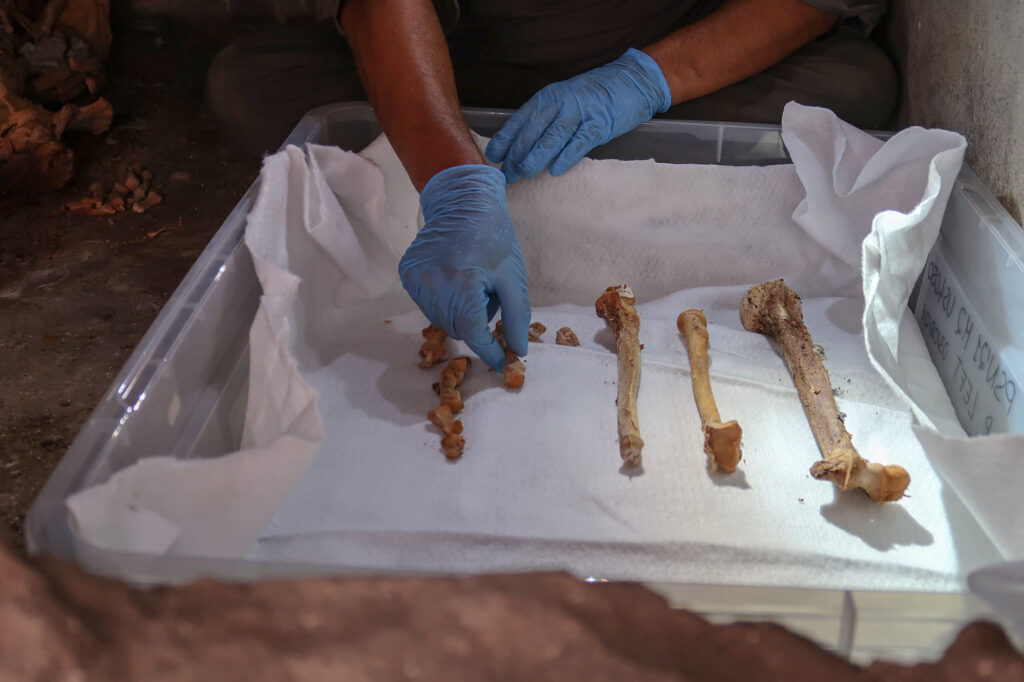This incredibly well-preserved 2,000-year-old body of a resident of Pompeii was found with hair still on the man’s skull and part of his ear intact, leading archaeologists to describe it as one of the best-preserved skeletons ever found in the city.
The partially mummified remains, identified by a name plaque on his tomb as ‘Marcus Venerius Secundio’, are estimated to be 2,000 years old and were found by researchers at Porta Sarno which is located to the east of the ancient Pompeii urban centre.
The excavation of the rectangular-shaped tomb was carried out by the Archaeological Park of Pompeii and the European University of Valencia.
Gabriel Zuchtriegel, director of the Archaeological Park of Pompeii, said in a statement that the inscription found in the tomb suggest that Marcus Secundio died in his 60s and at some point in his life he was enslaved.

The inscription on the tomb also revealed that after gaining his freedom, Marcus Secundio worked his way up the social ladder, eventually becoming a priest who carried out performances in an imperial cult both in Latin and Greek.
The inscriptions say that he gave Greek and Latin ‘ludi’ for the duration of four days which Zuchtriegel explained were public games held to entertain the public.
Zuchtriegel said: “It is the first clear evidence of performances at Pompeii in the Greek language, which had previously been hypothesized based on indirect indicators.”
These findings suggest that Pompeii was a multi-lingual city where cultures from the Eastern Mediterranean mingled.
Researchers believe that the tomb was beautifully decorated with a blue background and paintings of colourful plants covering the walls of the rectangular structure.
During the excavation, the team unearthed two funeral earns which according to the inscriptions belonged to Secundio’s wife who was referred to as Novia Amabilis (kind wife).
The find has baffled researchers who pointed out that funerals in Pompeii usually involved cremation with small children being the only ones who were buried.

Llorenc Alapont, an archaeologist from the University of Valencia, said: “We still need to figure out whether the partial mummification of the deceased is due to intentional treatment or not, analysis of the fabric could provide further information on this.”
Alapont added: “Even for those like me, who have been specialised in funerary archaeology for some time, the extraordinary wealth of information offered by this tomb, from the inscription to the burials, the osteological finds and the painted façade, is exceptional.”
Dario Franceschini, Italy’s minister of Cultural Heritage, commented on the finding saying: “Pompeii never ceases to amaze, and has confirmed her place in a story of redemption, as an international role model.”
He added: “It is a place where research and new archaeological excavations are taking place once more, thanks to the many professionals in the field of cultural heritage, who with their work never cease to produce extraordinary results for the world which are a source of pride for Italy.”
Fabrics and biological matter gathered at the site have been sent to the Laboratory of Applied Research at Pompeii, where they will be analysed and then prepared for conservation.

The tomb, where the mummy was discovered, located outside the city of Pompei, Italy. 
The inscription on the tomb, where the mummy was discovered, located outside the city of Pompei. 
The bones of the skeleton of a mummy found in a tomb outside of city of Pompei, Italy, who was a man called Marcus Venerius Secundio, a resident of the ancient Pompeii.
The Ananova page is created by and dedicated to professional, independent freelance journalists. It is a place for us to showcase our work. When our news is sold to our media partners, we will include the link here.




